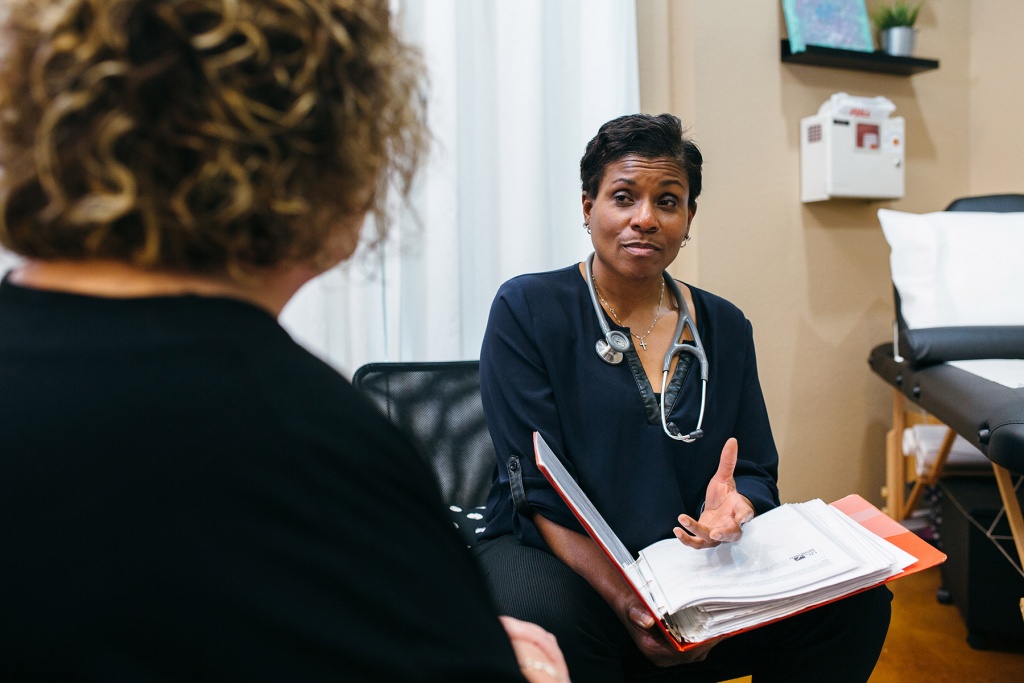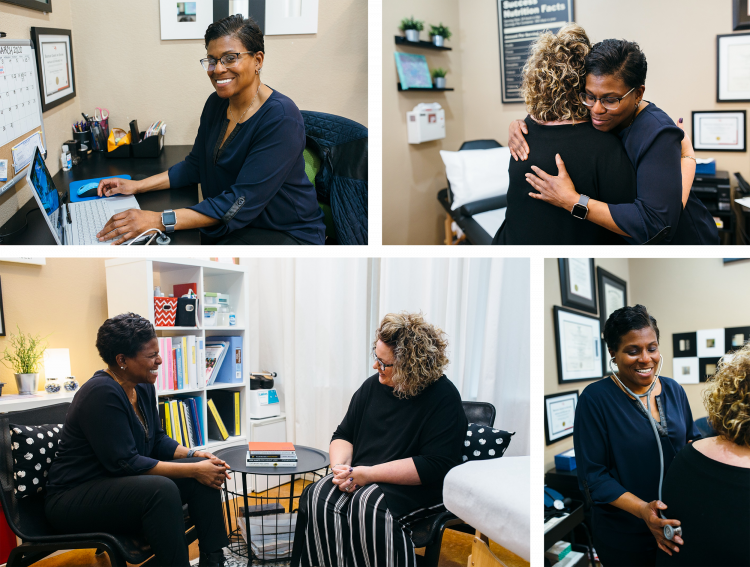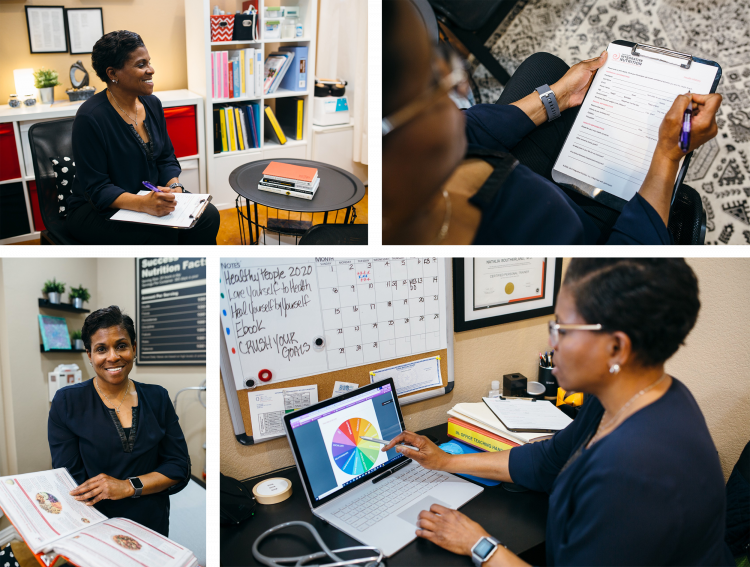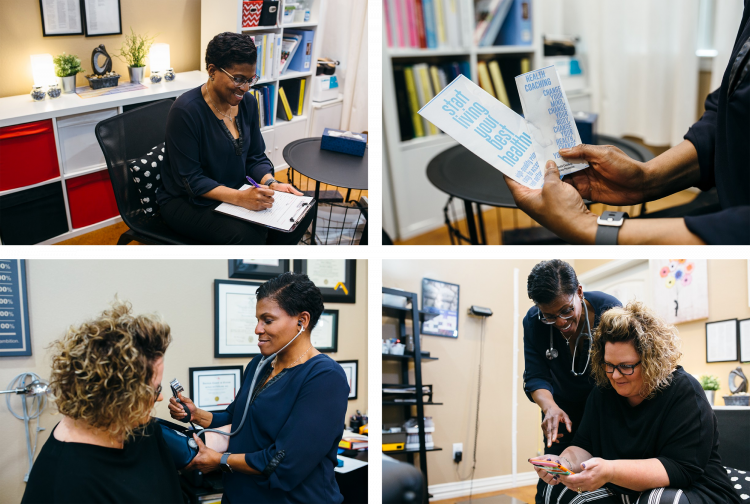As Medicine and Business Collide, One Physician Doubles Down on Uncompromising Care

It’s 2:23 a.m., and a solitary family physician is prowling the empty hospital hallways. This is her eighth shift in as many nights. Or is it her ninth? She’s not sure. Hurrying along, she checks her watch, hoping the date displayed on its face will resolve the mystery. But in the wee hours of the morning the lines between yesterday, today, and tomorrow start to blur. Counting backwards to the last time she got a full night of sleep requires more brain power than she can muster after — how many shifts was it again?
This physician’s name is Natalia Southerland, MD. She’s been practicing medicine for a decade and, in fact, it’s not her eighth or ninth shift but her tenth in the last 10 days. Dr. Southerland is fully aware that such a grueling schedule raises serious questions about whether she can provide the quality of care she believes her patients deserve. Those are more questions she doesn’t have the energy to answer right now, though, and in any case, they’re not the type of questions her employers seem too concerned about.
Still, long overnight hours in this hospital mark the start of a cascading list of reasons Dr. Southerland is burning out. She’s exhausted. She’s lonely. She’s the only non–emergency department physician in the building. The hours make it difficult to follow her true passion — forming meaningful connections with patients.
Despite all this, she volunteered for the graveyard shift.
Why? “I worked at night because I thought I could avoid administration,” she says.
Family Medicine and Independent Practice
For Dr. Southerland, a decades-long journey through medicine is best understood as the battle between two conflicting forces — the healthcare system’s increasing administrative pressure to protect its bottom line, versus her personal ambition to connect with patients and offer them superlative care.
Now, at the tail-end of that battle, Dr. Southerland is the owner of Brand New Med, an independent family practice in Waxahachie, Texas, a small town just beyond the southern suburbs of Dallas. Nearby, American healthcare marches forward, for better or worse. Big health systems consolidate, administrative spend approaches $500 billion, and physicians continue to report feeling burned out and disconnected from their patients.
Dr. Southerland knows that her values make her a perfect fit for Direct Primary Care (DPC), a model where the priorities are independently set by physicians without oversight from medical administrators. Like Dr. Southerland, many DPC doctors measure success in quality — both in terms of patient relationships and outcomes — rather than quantity, as is common in larger health systems.

Thanks to the DPC model that gives physicians more freedom, Brand New Med stands apart as a haven that attracts patients who want more from their providers. “In my practice I like to treat people like I would treat my family,” Dr. Southerland says. She attributes this deep-seated belief to her late grandmother, whose willingness to care for others was boundless, sharing that she “gave help selflessly, but needed very little help herself.” It’s that philosophy Dr. Southerland now uses to steer her practice: Do the best job you can for the people who depend on you, but make your own decisions about what “best job” really means.
Brand New Med has experienced tremendous success. Dr. Southerland’s patients are vocal about the quality of the experience in her practice on Google and Facebook. “Old fashioned medicine meets the modern world!” one patient writes. “Dr. Southerland is very thorough…You won’t find a practice with double-booked 15-minute back to back appointments here. I never feel rushed and I feel like a valued person, not a number or a paycheck.”
The Search for Community
Each appointment at Brand New Med is an hour long, “period —end of story,” Dr. Southerland says. “That’s the time that I need to be able to examine a patient, sit with them to talk, and understand why they’re doing what they’re doing.” Longer sessions help strengthen community bonds and establish a culture of reciprocal support — two themes that Dr. Southerland first encountered during her undergraduate studies at Georgetown University. As she made her way through medical school at the University of Pittsburgh and residency at the University of Maryland at Baltimore, these themes gained meaning. Now, at Brand New Med, they’re foundational.
As a young student, Dr. Southerland explains that she and many of her African American peers felt isolated. “There were many times we ended up in the bathroom crying because we just felt like people couldn’t understand what we were talking about,” she says. That changed when she began to bond with African American upperclassmen, who she described as unwaveringly supportive. “They always had your back. They’d say, ‘Look, we got through this. We’re here for you. You can get through it, too,’” Dr. Southerland reflects. “It’s that level of community that I appreciate…we were like family at that point.”
Her years of higher education and residency rank among the best of her life because of the strength of the relationships she built, Southerland remembers. She bonded with a diverse group of supportive friends in an open-minded culture. She followed in the footsteps of mentors who listened to her and respected her opinions. She learned inside and outside the classroom and gave back — both by volunteering in local, underserved communities and by mentoring the underclassmen who were searching for a sense of belonging, like she once had.
Dr. Southerland’s first “real job” — a stint at the National Health Service — brought more of the same exceptional community she experienced during her education. “They wanted to do whatever they could to help the clients that they were serving,” she says, including community diabetes programs and mammogram screening events with door prizes. There was a purpose inherent in the work at NHS that aligned with Dr. Southerland’s values, afforded her the opportunity to do her best for her patients, and allowed for deep integration with her community.
The Way It Is and the Way It Could Be
As her career progressed, the presence of purpose and strong, patient-oriented values faded quickly amid increasing pressure to meet performance standards. Dr. Southerland describes her first job at a health system as one where the feedback loop between administrators and physicians was nonexistent and cultivating purpose required a game of mental gymnastics. “In the real world where you’re employed, it’s like, ‘Just shut up and do what we ask you to do,’” she says.
The ensuing years were characterized by a constant race to sneak in as much meaningful patient time as possible before administrators caught on. “There’s always been this pressure to see more patients when, for me, it was always the quality of the care that was important,” she says.
Dr. Southerland hopped from hospital to hospital, butting heads with administrators at each juncture. Working conditions were far from optimal. She describes stretches where she couldn’t take five minutes to go to the bathroom without fear of reprimand. Administrators threatened to cut salaries if employed doctors didn’t see more patients. Burnout was an everyday reality. “It was horrific. I had to go to a psychiatrist because I would be on call three weekends in a row. It was craziness,” she says. “In what world was that safe for me or for the people I was taking care of?”
After a series of failed attempts to work at big health systems that brought more dissatisfaction, Southerland landed a job at a physician-owned multi-specialty practice in South Florida. The owner’s experience as a physician was evident in his leadership. Physician staff members were part of a support system where nurses and other clinical staff shouldered administrative burden, freeing doctors to engage with patients. For the first time in years, Dr. Southerland could leave work without taking her charts home. Even better, she could spend quality time and build relationships with her patients.
After three years of service, Dr. Southerland learned that the owner would sell his practice to a health system. The news was hard to take, but she approached the change with an open mind. It wasn’t long, though, before she was, once again, face-to-face with the type of administrators she had sought to leave behind. Now that she’d had a taste of what medicine could be — an open-minded, mutually supportive environment that valued patient and physician satisfaction — she found it hard to accept anything less.
Now that she’d had a taste of what medicine could be — an open-minded, mutually supportive environment that valued patient and physician satisfaction — she found it hard to accept anything less.
Within six months of the sale, Dr. Southerland found herself playing another game of hospital hopscotch. Beneath the façade of busy-ness and the frustrations of following orders she felt didn’t benefit her patients, burnout rose to a boil. After 20 years, it felt like there was no escaping the system that so adamantly clashed with her values.
Desperate for answers, Dr. Southerland reached out to Dr. Pamela Wible, a physician widely known as an advocate for physician well-being. “I didn’t think she was going to answer the phone. But she did. She talked to me for 45 minutes, and she was like, ‘You do realize you don’t have to do it this way, don’t you?’” Southerland says. “At that point I didn’t know exactly what I was going to do or exactly how I was going to do it. But I knew I just had to figure out a way.”
Go Your Own Way
Dr. Southerland took the leap into direct primary care. It’s been two and a half years since she launched Brand New Med. Every day, she lives in alignment with her values, and it shows; her patients can’t speak highly enough of her practice. It has more than 40 online reviews, and not one is less than five stars.
In hindsight, she sees her journey as one that has always pointed toward independent practice. “What I was doing every day really wasn’t making a difference for the patients,” Dr. Southerland says of her years as an employed physician. “People are just coming in and going out. We’re taking their money and spending seven or eight minutes with them, but we’re not really helping them make the change that needs to be made.”

Now, at Brand New Med, patient well-being is a team effort. Dr. Southerland’s patients feel like family to her and, from their perspective, Brand New Med is an integral part of the South Dallas community.
Recently, Dr. Southerland buttressed her medical degree with a health coaching certification because she wanted to do more than diagnose and prescribe. Health coaching empowers her to support patients during the most difficult parts of the care continuum — making meaningful lifestyle changes.
Not long after earning the certificate, Dr. Southerland spent a year educating a group of women with prediabetes about lifestyle changes that could help them avoid becoming diabetic. It’s an experience that has tied together all the best elements of her training and values at once: community, family, and independence.
A year later, things are looking good.
“These women staved off diabetes,” Southerland says. “That’s probably the biggest thing for me about independent practice — I actually get to see my work work.”






